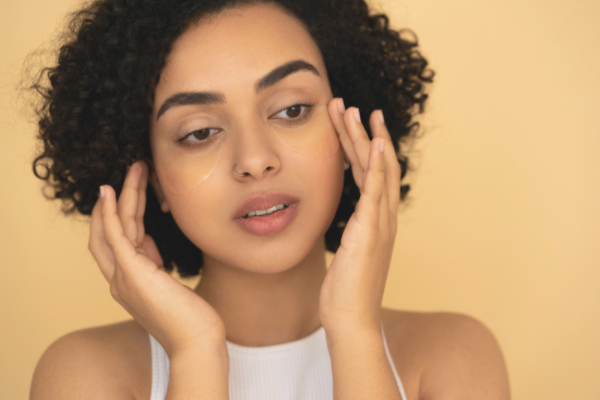December 20, 2021
Uneven Skin Tone: What It Is & How To Fight It
Mention ‘collagen supplements’ to any beauty enthusiast and he or she might rave about it being a powerhouse of wonders.

It appears out of nowhere.
One day you look into the mirror and notice a patch of skin that has a different color than the rest of your face, or that spot of brown is growing more and more visible as days go by.
What’s happening here, and is it permanent?
Those are what we call dark spots or uneven skin tone. This is also known as hyperpigmentation; otherwise defined as what happens when patches of skin become darker in color due to excess melanin depositing in the skin’s surface.
The common form of hyperpigmentation appears as small, flat, and darkened patches of skin that are light brown to black in color.
If you’re reading this, chances are you know it is a problem that is affecting you, and you’re looking for a way to treat and get rid of it.
But before we break into our banks buying every product and signing up for treatments targeting uneven skin tones and dark spots, let’s take a look and understand what causes hyperpigmentation and how to counter it.
6 Reasons for Dark Patches On Your Skin
Having uneven skin tone can be temporary or permanent, and it all depends on how you cope with it!
Here are the most commonly listed reasons for hyperpigmentation.
1. Sun Exposure

It’s not just that the sun causes a friendly glow; it’s also that prolonged exposure can trigger the production of excessive melanin.
Of course, this results in darker, shaded skin with patches of discoloration and dryness.
This doesn’t mean you have to avoid the sunlight at all costs – instead, protect yourself from it using the right SPF sunscreen for good coverage.
2. Age

Age is one of the most common factors when it comes to the development of dark spots on the skin.
As we age, the production of collagen and elastin in our skin begins to degrade.
This leads to a loss of elasticity and strength which could eventually lead to permanent changes in the skin by causing small tears or openings at the surface of the skin.
3. Acne and acne scars

Acne occurs when oil and dead skin cells accumulate beneath the skin’s surface. This leads to specially shaped papules (whiteheads) and squamous cells (dark brown or blackish patches) appearing on the face, arms, or legs.
Acne can be treated with over-the-counter solutions such as commercial acne creams.
If the acne remains untreated, it can lead to semi-permanent scarring that lasts a long time otherwise known as post-inflammatory hyperpigmentation (PIH) or acne scarring.
4. Hormonal changes

Hormonal changes during pregnancy can cause your skin to change color.
Changes in the levels of folate, vitamin B6 and hormones can promote hyperpigmentation especially in women who are on oral contraceptives or using testosterone blockers.
Hormonal changes associated with menopause can also cause your skin to become wrinkled. When this happens, dark spots and brown patches may appear on the face.
5. Injury

The genetic makeup of each person is different. Each pigment that makes up our skin — from pigment-containing proteins to vitamin D — is contained in a single unit called a melanocyte.
When an injury occurs, the melanocyte releases chemicals that cause hyperpigmentation.
If the injury is severe enough, it can cause dark spots (hypopigmentation) on the surrounding tissue and/or open sores that allow bacteria and/or infection to enter the body.
6. Medications

Most medications for acne are known to have side effects. Therefore, it’s important to discuss these effects with your doctor before starting any medication.
Uncontrolled melanin production leads to skin developing unwanted patches of darker skin on the face.
Best Ways to Counter and Prevent Future Hyperpigmentation
If having dark spots, freckles, and patches of skin that is a different shade than the rest of your face is something you want to avoid, there are a few things you can do now to prevent it from happening or make it worse.
1. Stay hydrated!

First and foremost, stay hydrated.
You may know this already, but keeping your skin supple by drinking enough water a day (it is suggested that we drink at least 8 glasses per day) is super important so that our skin has the ability to not only flush out toxins but hydrated enough to benefit from your skincare products.
2. Use appropriate skincare products and routines
Some people benefit from using very little to no skincare products at all, but that routine does not work for everyone. Have at least a cleanser, moisturizer, and sunscreen in your daily routine.
Test products on your neck or on the inner part of your wrist to see if there’s any adverse reaction before applying on your face, as certain products may trigger skin inflammation and leave scars that darken over time.
3. Choosing the right sunscreen
Sun exposure is the number one culprit behind hyperpigmentation.
That’s why whenever you head outdoors, it is a good rule of thumb to apply sunscreen or a broad-spectrum moisturizer with at least SPF 30 or higher.
4. Avoid junk food and maintain a healthy diet.

Stop digging your hand into that bag of chips already!
Excessive amounts of salt and sugar can trigger cellular stress Unhealthy food consumed may result in skin flushing, dryness, and wrinkles.
For skin’s that healthy and youthful, avoid these problematic food and drink:-
5, Get enough sleep.
Sometimes, increasing the antioxidant levels is not difficult. Just hit the snooze button of your alarm clock and have a good sleep!
6-8 hours of sleep significantly improves brain function, regulates hormone production and reduces stress levels in your body – allowing for healthier-looking skin when you wake.
6. Supplements & vitamins for skin

We’re talking about vitamins that the skin needs to give you that glowy and dewy look. These could come from a food source, or in the form of a tablet or drink.
Make sure your daily sustenance includes vitamins such as:-
To truly heal hyperpigmentation and avoid future dark spots, a healthy gut is needed. This means that your diet needs to include skin-friendly nutrients, vitamins, and antioxidants on a regular basis.
Snowbebe helps significantly with:-
Those who have already embarked on their Snowbebe journey see significant results in 2-3 months of consumption.
Snowbebe is safe to consume and is formulated with nutrient-rich ingredients to improve complexion from the inside out.
See brightness today, and start your Snowbebe adventure here!
Or go here for more details on Snowbebe’s list of ingredients.
References :-










